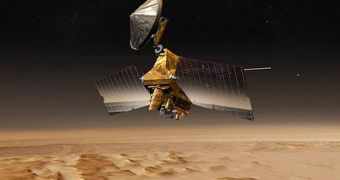Officials at the American space agency announce that the Mars Reconnaissance Orbiter (MRO) has exceeded an incredible milestone in its mission to observe the Red Planet; the vehicle has thus far relayed more than 200 terabits of data back to Earth, over its 10-year mission.
This value does not include the engineering data that the MRO usually communicates to experts at the NASA Jet Propulsion Laboratory (JPL), in Pasadena, California, and at Lockheed Martin Space Systems, in Denver, Colorado, who are in charge of keeping the old spacecraft in good condition. .
An interesting fact to note here is that the MRO single-handedly transmitted more data back to NASA via the Deep Space Network antennae than all other missions using this relay station combined. In fact, the orbiter sent three times the amount of data of all other spacecraft.
About 0.1 percent of the MRO data were accounted for by communications the orbiter forwarded from rovers on the surface of Mars. These include the Spirit and Opportunity Mars Exploration Rovers, the Mars Science Laboratory rover Curiosity, and the Phoenix Mars Lander.
The remaining 99.9 percent of data were obtained directly from the six instruments aboard the orbiter. Experts say that 200 terabits of data are sufficient to hold three months of high-definition videos, playing around the clock.
“The sheer volume is impressive, but of course what's most important is what we are learning about our neighboring planet,” says JPL MRO project scientist, Rich Zurek. He adds that the spacecraft sends data to Earth from a 3-meter (10-foot) antenna.
The power required for transmitting information over such long distances is produced by a 20-square-meter (215-square-foot) array of solar cells. The spacecraft requires that antennae in California, Spain and Australia face it several times per day in order to be able to relay all of its data.
“Mars Reconnaissance Orbiter has shown that Mars is still an active planet, with changes such as new craters, avalanches and dust storms. Mars is a partially frozen world, but not frozen in time,” Zurek says.
The orbiter launched into space on August 12, 2005, and reached its destination on March 10, 2006. Over the past 7 years, it has contributed tremendously important information for our understanding of Mars, and has helped NASA experts stay in contact with other missions as well.

 14 DAY TRIAL //
14 DAY TRIAL //